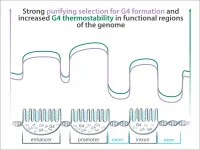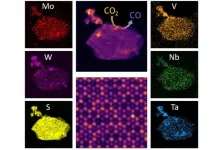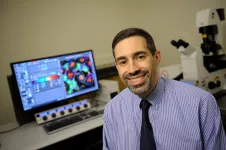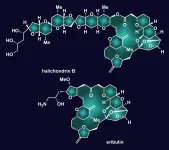Paving the way to artificial photosynthesis -- effect of doping on the photocatalyst SrTiO3
New study shows how doping affects the charge properties of a photocatalyst, potentially paving the way for better solar energy conversion
2021-06-29
(Press-News.org) For many years, researchers have been focused on developing technologies that can help us fight the imminent climate change crisis. They have one goal in common: finding sustainable energy sources that can replace the environmentally toxic fossil fuels. "Photocatalysts" that drive an artificial process that replicates photosynthesis (in which solar energy is converted to useful materials) are promising in this regard, given that we are able to develop the technology needed for them. Crystalline materials, such as strontium titanate (SrTiO3), which can serve as "photocatalysts" in solar devices, can lead us in the direction.
SrTiO3 is attractive owing to various other reasons too, such as its potential applications in resistive switches and fuel cell components. The versatile nature of SrTiO3 has motivated physicists to study its various materials properties in detail. But to dig deeper into the properties of SrTiO3, we need to understand a little more about them.
Photocatalytic materials such as SrTiO3 are usually "doped" with chemicals like niobium (Nb) that help to improve their electrical properties. But a process called "charge recombination" can occur in photocatalysts, which hampers with their efficiency. In this process, mobile charge carriers present in the material, such as "electrons" and "holes," when exposed to light, can annihilate each other. Some studies have shown that charge recombination is affected by the presence of defects in crystals. So how does Nb doping affect the material properties of SrTiO3? This is exactly what a team of researchers at Nagoya Institute of Technology, Japan, led by Prof. Masashi Kato, wanted to find out.
In their study published in Journal of Physics D: Applied Physics, the researchers looked at the effects of low-concentration Nb doping, as well as no doping, on the surface recombination in SrTiO3 crystals. Prof. Kato explains, "Quantitatively measuring the effects of surfaces and niobium impurities in SrTiO3 on carrier recombination can help us design photocatalysts with an optimal structure for artificial photosynthesis."
The scientists first analyzed the surface recombination, or "decay," patterns of undoped SrTiO3 samples as well as those doped with different concentrations of Nb, using a technique called "microwave photoconductivity decay." To further probe into the bulk carrier recombination properties of doped samples and different energy levels introduced by Nb doping, another technique called "time-resolved photoluminescence" was used.
The researchers found that the recombination of excited carriers was not dependent on their concentration, indicating that they recombined via "surface"" and "Shockley-Read-Hall" processes (which are insensitive to exciting carrier concentration). Moreover, the doped sample showed faster decay curves, which could be due to the introduction of a recombination center by Nb doping. Doping the material with high concentrations of Nb showed negative effects on carrier doping. Moreover, the size of the photocatalyst, and not its shape, influenced surface recombination and ultimately its overall efficiency.
The study concluded that moderately Nb-doped SrTiO3 could actually be more beneficial than pure SrTiO3, especially when operated at higher operating temperatures. These findings can help us design SrTiO3 photocatalysts with a lower surface recombination and higher energy conversion, leading to the development of efficient, sustainable sources of energy.
Prof. Kato optimistically concludes, "We are confident that our findings can accelerate the development of artificial photosynthesis technologies, ultimately contributing towards a greener, more sustainable society."
INFORMATION:
About Nagoya Institute of Technology, Japan
Nagoya Institute of Technology (NITech) is a respected engineering institute located in Nagoya, Japan. Established in 1949, the university aims to create a better society by providing global education and conducting cutting-edge research in various fields of science and technology. To this end, NITech provides a nurturing environment for students, teachers, and academicians to help them convert scientific skills into practical applications. Having recently established new departments and the "Creative Engineering Program," a 6-year integrated undergraduate and graduate course, NITech strives to continually grow as a university. With a mission to "conduct education and research with pride and sincerity, in order to contribute to society," NITech actively undertakes a wide range of research from basic to applied science.
Website: https://www.nitech.ac.jp/eng/index.html
About Associate Professor Masashi Kato from Nagoya Institute of Technology, Japan
Dr. Masashi Kato graduated in Electrical and Computer Engineering from Nagoya Institute of Technology in 1998 and then proceeded to obtain both a Master's (2000) and a PhD (2003) in the same field. He is currently an Associate Professor of Semiconductor Physics and has published over 70 papers in the course of his career. His field of expertise and research interests lie within electronic/electric materials and device-related chemistry. He has also been a member of The Japan Society of Applied Physics for nearly two decades.
[Attachments] See images for this press release:
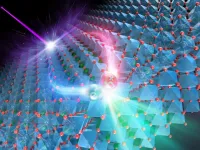
ELSE PRESS RELEASES FROM THIS DATE:
2021-06-29
Basic needs of disaster- and conflict-impacted refugees are often met by humanitarian relief goods and services, and until now little was known about how refugees create economic livelihood beyond immediate relief.
A new exploratory case study from Portland State University Associate Professor of Management Theodore Khoury reveals how Syrian refugees in the Za'atari camp reached beyond basic disaster relief support and leveraged social capital to create informal economic systems that helped improve their quality of life. The study, "Towards a theory of informal supply networks: An?exploratory case study of the Za'atari refugee camp," is published in the Journal of Operations Management and co-authored by ...
2021-06-29
PHILADELPHIA - The use of e-cigarettes, or vaping, causes serious damage to the lungs. After the novel coronavirus responsible for the respiratory disease COVID-19 emerged last year, there have been ongoing concerns about how vaping might impact risk of infection and severity of symptoms. Some evidence shows an increased risk of COVID-19 among those who vape. Research also shows a higher COVID-19 mortality rate in men compared to women, and men are more likely to vape than women. However, there is no evidence to link these two observations.
New research from Jefferson sheds light on this by showing that exposure to e-cigarette vapor increases levels of the coronavirus receptor in the lungs ...
2021-06-29
A 50% rise in the level of carbon dioxide (CO2) in the atmosphere could reduce rainfall in the Amazon as much as or even more than substitution of the entire forest by pasture. The rise in CO2 would reduce the amount of water vapor emitted by the forest, leading to a 12% annual drop in the volume of rainfall, while total deforestation would reduce rainfall by 9%.
These estimates are presented in a study published in Biogeosciences by scientists affiliated with the National Space Research Institute (INPE), the University of São Paulo (USP) and the University of Campinas (UNICAMP) in Brazil, and with Munich Technical University (TUM) in Germany.
“CO2 is a basic input for photosynthesis, so when it increases in the atmosphere, plant physiology ...
2021-06-29
Some regions of the human genome where the DNA can fold into unusual three-dimensional structures called G-quadruplexes (G4s) show signs that they are preserved by natural selection. When G4s are located in the regulatory sequences that control how genes are expressed or in other functional, but non-protein coding, regions of the genome, they are maintained by selection, are more common, and their unusual structures are more stable, according to a new study. Conversely, the structures are less common, less stable, and evolve neutrally outside of these regions, including within the protein-coding regions of genes themselves.
Together, these ...
2021-06-29
A two-dimensional alloy material -- made from five metals as opposed to the traditional two -- has been developed by a collaboration between researchers at the McKelvey School of Engineering at Washington University in St. Louis and researchers at the College of Engineering at the University of Illinois at Chicago.
And, in a first for such a material, it has been shown to act as an excellent catalyst for reducing CO2, into CO, with potential applications in environmental remediation.
The research, from the lab of Rohan Mishra, assistant professor in the Department of Mechanical Engineering & Materials Science at ...
2021-06-29
A team of neuroscientists at the Beckman Institute for Advanced Science and Technology led by Baher Ibrahim and Dr. Daniel Llano published a study in eLife that furthers our understanding of how the brain perceives everyday sensory inputs.
"There is a traditional idea that the way that we experience the world is sort of like a movie being played on a projector. All the sensory information that is coming in is being played on our cerebral cortex and that's how we see things and hear things," said Llano, a Beckman researcher and associate professor in the Department of Molecular and Integrative Physiology at the University of Illinois ...
2021-06-29
Many drivers use tollways to get from point A to point B because they are a faster and more convenient option. The fees associated with these roadways are higher during peak traffic hours of the day, such as during the commute to and from work. With this structure, drivers who are not adding to the heavy flow of traffic do not have to pay higher toll prices. However, those who utilize the toll road during more congested hours pay a premium to use the faster, more convenient highways.
Similarly, not everyone uses the same amount of electricity throughout the day. There are peak load hours that put more strain on the grid, and there are users within those times who use more electricity ...
2021-06-29
HOUSTON - (June 29, 2021) - The story of halichondrin B, an inspirational molecule obtained from a marine creature, goes back to the molecule's discovery in an ocean sponge in 1986.
Though it has been replicated in the laboratory several times before, new work by Rice University chemists could make halichondrin B and its naturally occurring or designed variations easier to synthesize.
Synthetic chemist K.C. Nicolaou and his lab reported in the Journal of the American Chemical Society their success in simplifying several processes used to make halichondrin B and its variations.
Halichondrin's molecular structure and potent antitumor ...
2021-06-29
Dark Energy is widely believed to be the driving force behind the universe's accelerating expansion, and several theories have now been proposed to explain its elusive nature. However, these theories predict that its influence on quantum scales must be vanishingly small, and experiments so far have not been accurate enough to either verify or discredit them. In new research published in EPJ ST, a team led by Hartmut Abele at TU Wien in Austria demonstrate a robust experimental technique for studying one such theory, using ultra-cold neutrons. Named 'Gravity Resonance Spectroscopy' (GRS), their approach could bring researchers ...
2021-06-29
Scientists have discovered how plants manage to live alongside each other in places that are dark and shady.
Moderate shade or even the threat of shade - detected by phytochrome photoreceptors - causes plants to elongate to try to outgrow the competition.
But in the deep gloom of a dense forest or a cramped crop canopy where resources and photosynthesis are limited, this strategy doesn't work. In these conditions it would be a waste of energy and detrimental to survival to elongate stems because seedlings would never be able to over-grow larger neighbours.
So how do plants prevent elongated growth under deep shade conditions? The secret lies in their internal clocks, says the research collaboration from the John Innes Centre ...
LAST 30 PRESS RELEASES:
[Press-News.org] Paving the way to artificial photosynthesis -- effect of doping on the photocatalyst SrTiO3
New study shows how doping affects the charge properties of a photocatalyst, potentially paving the way for better solar energy conversion


